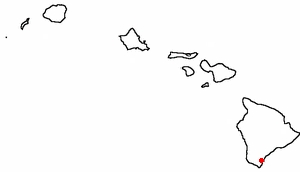
 |
Punalu'u Black Sand BeachVisited 16 January 2007 |
After two days on the volcano, we started our clockwise (from about 4 o'clock) car journey around the Big Island. One of our first stops was the most accessible black sand beach in the state: Punalu'u Black Sand Beach Park, just off Highway 11. This is true black sand [174]which is formed when the cold ocean pulverizes the flowing a'a lava bits. Older islands have black beaches, but these are made up of lava chipped off river beds by rushing water. Not the same at all. Notice the fine texture of the black sand below found only on this part of the Big Island where the volcanoes meet the sea:
Punalu'u in Hawaiian means "diving spring" and reminds natives of droughts where the best way to get fresh water was to dive into the freshwater springs just offshore with their gourds. In fact, many arid shoreline Hawaiian communities depended upon such surface water. (Fresh water has a less specific gravity and floats on top of the salt water.) These same springs today make the top 8-12 inches of water here very cold. Notice below the lack of swimmers:
While this side of the island generally has poor beaches due to its rough surf and rainy-side river runoff, Punalu'u is a spectacular beach edged by classic palm trees in the background and by naupaka bush in the foreground. It's what you expect of a great Hawaiian beach except it's black in the middle:
While the water can be cold, the beach is warm and suitable for basking by the area's most popular (but officially threatened) inhabitants, the Green Sea Turtle. Supposedly the water here is rife with these turtles, but we saw only this one. (Hawksbill Turtle also feeds in this area but apparently only comes to the beaches at night.)
Green turtles (called Honu in Hawaiian) can weigh up to 500 pounds, making it the largest of the hard-shelled turtles. It doesn't look too green in the above picture (it gets its name from its body fat which is green probably because of their diet of sea grass and algae --called limu in Hawaiian). Tourists are asked to keep 15 feet away at all times. Trivia: are turtles really slow? Ocean turtles can swim at 35 miles per hour. It may be flippant to call them slow.
Here's another hard-shelled and cold-blooded specimen, well on his way to 500 pounds, especially after this trip:
Rather than algae, we next opted for lunch and the legendary pies at the southernmost cafe in the United States in nearby Na'alehu.
![]()
This
work is licensed under a Creative
Commons Attribution-NonCommercial-NoDerivs 2.5 License.